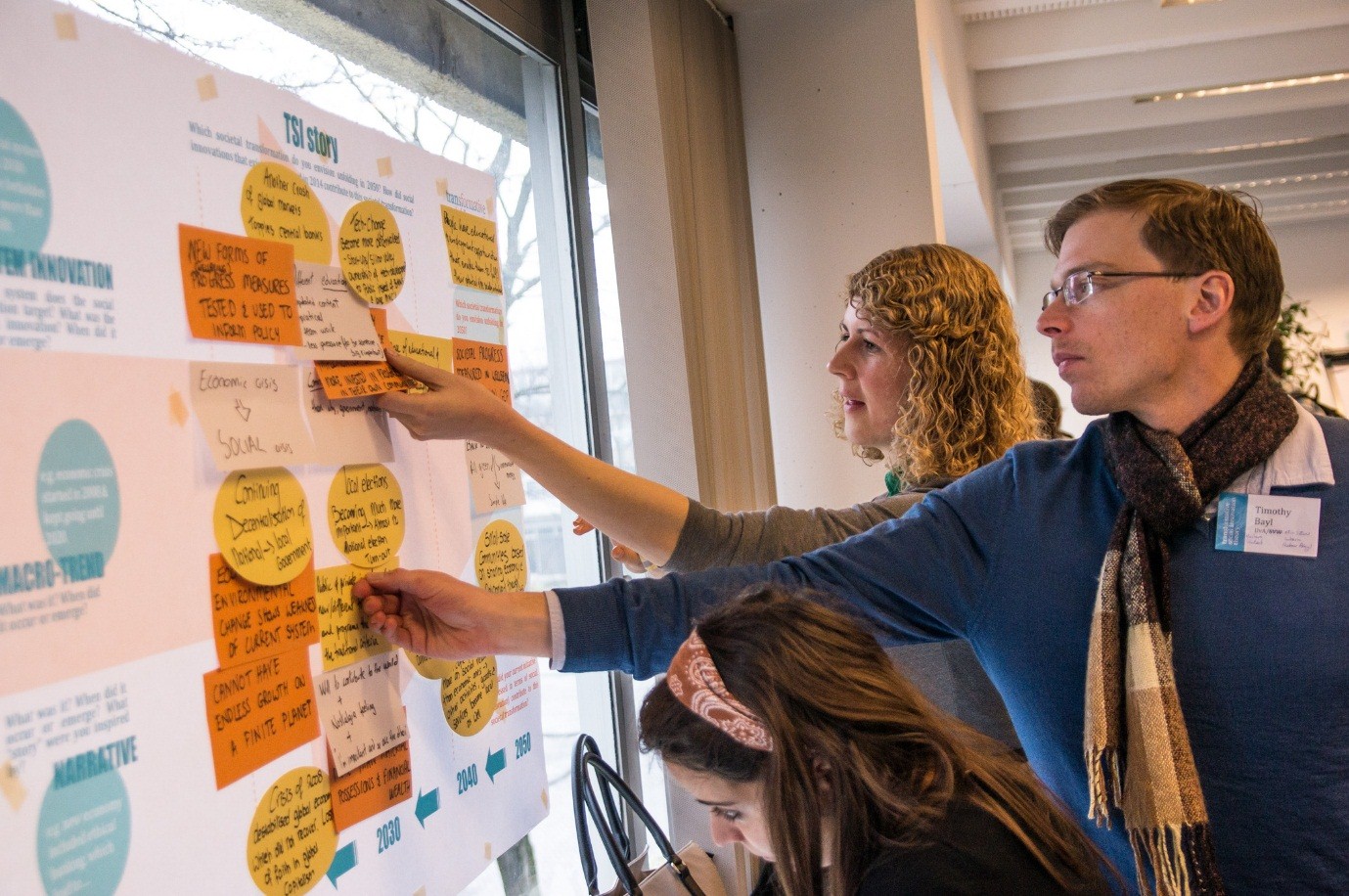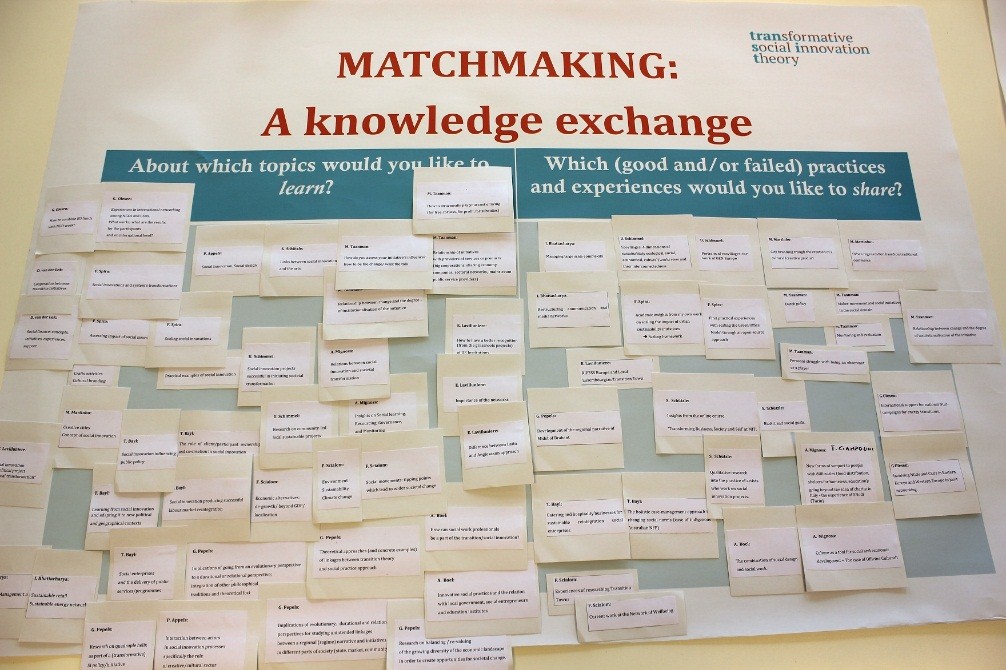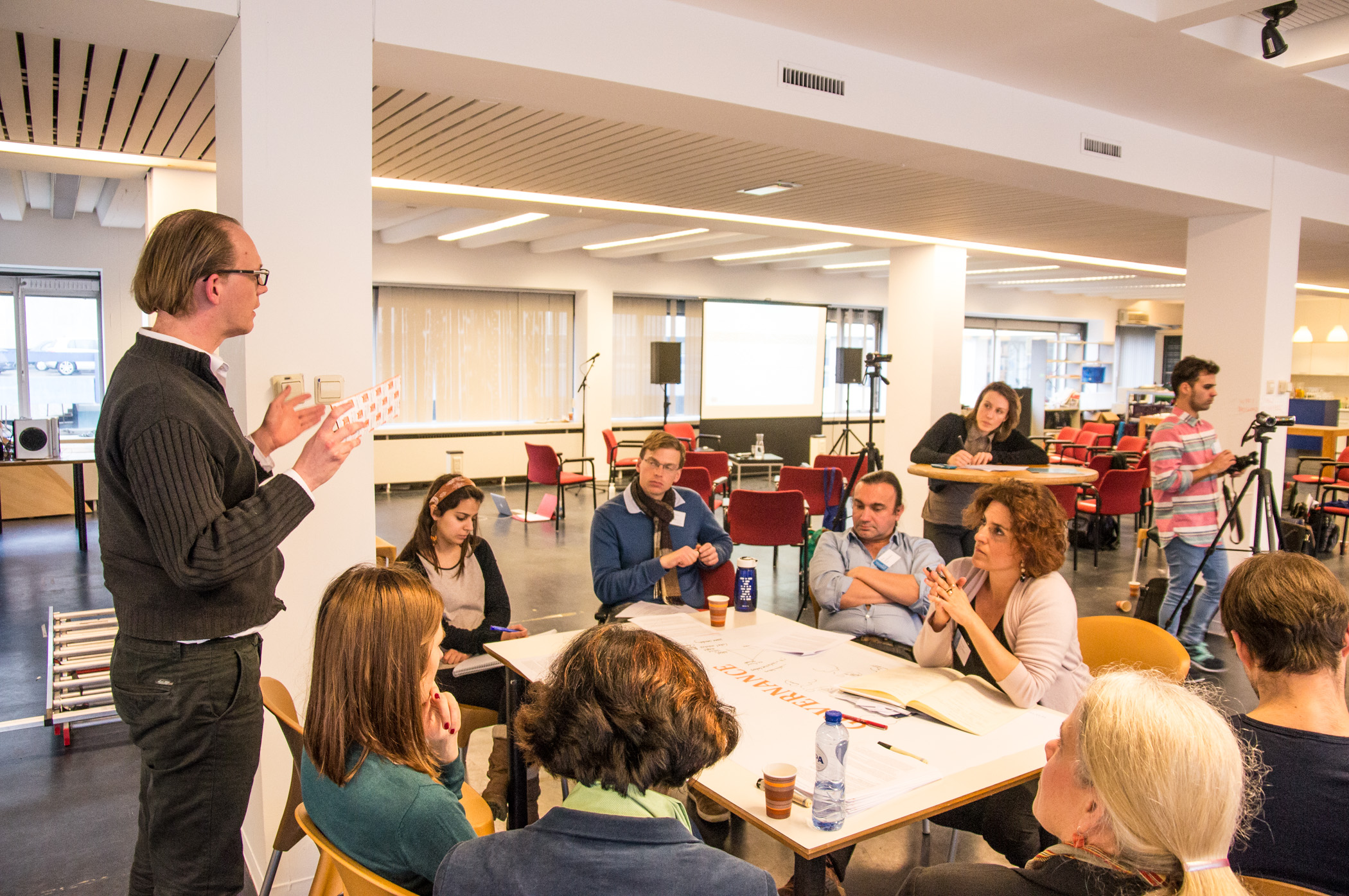By Veronica Olivotto & Linda Zuijderwijk (IHS).
The workshop for social innovators and entrepreneurs, policy-makers and others took place in what is known as the ‘Yellow building’ in the Zomerhofkwartier, north-east of Rotterdam’s city centre. This building functions as a co-working space for a variety of professionals in the fields of public space and interior design, urban planning, illustration, cinema and music.
The call for workshop’s participants was spread across our TRANSIT research network since our main target group for information dissemination are, in this case, the professionals working in the transnational networks and their respective local manifestations. The main targets of the engagement workshop were Europe-based representatives of some of the 12 transnational networks and respective local manifestations working within TRANSIT. These were the Global Ecovillage Network (Europe), International Network for Sustainable Energy (Inforse) (Denmark), the Intercontinental Network for the Promotion of Social Solidarity Economy (RIPESS) (Europe representative), Transition Towns (Wekerle), Ashoka, the largest network of social entrepreneurs worldwide (Hungary). We also launched an open call which was answered by a diverse group of participants ranging from universities, to local and international action collectives working on solidarity and culture, to professionals working at the interface between regional development and social innovation and coming from the Netherlands, Italy and the UK.
We spent time thinking about the kind of interaction environment we wanted to experience during the day. Participants should be both receivers of information as well as active producers. This meant that the actual space for interaction had to be conducive to this, so we strived for a combination of formats: from open and diffused (plenaries and talk-shows), to more closed and targeted (story-telling and back-casting, café conversations) and also more casual and free interaction spaces.
During the plenary presentations we shared the theoretical building blocks that we use to study transformative social innovation and the TRANSIT research approach. The plenaries had also the purpose to introduce examples of the transnational networks part of the project. For example, Ulrike from the Global Ecovillage Network of Europe talked about its origin, internal and external organization and driving forces. As social innovation has become an explicit policy goal at the EU but also at national, regional and local levels in many countries we asked Friso Comou, from the Dutch Ministry of Internal Affairs, to tell us how he’s been using concepts from theories of transition management to explain social innovation and societal change with metaphors that policy makers can relate to. His aim is to bridge the gap between the language of policy and that of innovation practice.

The talk-show format made us reflect on the different ways in which we can make accessible the findings of our research to people. We presented the first preliminary research findings coming from the in depth research done with the first 12 social innovation trasnational networks and their respective local manifestations. Findings included a description of the historical and development trajectories of the network initiatives and a general overview of the age and size of the different networks.
The use of story-telling and back-casting in the workshop was a means to test a prototype process (called TSI-story) to guide practitioners and entrepreneurs’ thinking about ways of societal change. This is part of our main aim to make TSI theory practically relevant and contribute to building capacity of professionals working in the field of social innovation. The participants were asked to design their TSI-story by thinking back from 2025: which societal transformations would have taken place by then? And how did ‘their’ social innovation contribute to that? By testing this prototype we learned that some of the concepts we work with may be difficult to grasp because of their abstract qualities and this triggered us to further refine concepts, their explanation and visualization.

Inspired by the Bank of Common Knowledge, we added a knowledge exchange match making area. We asked all subscribed participants to tell us in advance what are the topics they would like to learn more about from other participants and which, instead, are the good or bad practices and experiences they can share. Based on their answers we set up a board where people could see whether their interests were matching. Participants’ enthusiasm and contributions have been overwhelming. The things people wanted to learn went from very practical (cultural branding; various ways to pay your cost of living; how to assess an initiative’s influence) to more research oriented questions (tipping points of social movements leading to societal change and how to adapt learning from SIs into new political and geographical contexts). Most insights the participants proposed were related to people’s current projects (e.g. new forms of support for disadvantaged people; culture as a tool for social and economic development; experiences researching or working in a specific SI movements) but also to sharing insights from academic work (e.g. scaling urban sustainability initiatives, the makers-movement; insights on qualitative research for SI). The matchmaking was largely left up to participants. Once they saw a topic of interest for them, they could approach the person who was able to talk about this topic. We hope that the knowledge sharing area stimulated people that initiated a conversation during the workshop to carry it on outside.

The neighbourhood walk was an important break in the dense morning program and it offered a glimpse of the different spontaneous social initiatives taking place in Zomerhofkwartier. These include an affordable vegan neighbourhood restaurant, whose owner teaches gardening skills to neighbourhood children, a local felt factory, and various urban gardening spots maintained by neighbours. It became clear that the retaking of this vacant building and spaces in the neighbourhood can be thought of as an example of social innovation in the renegotiation of urban space with public/private authorities and a meeting place where social innovations can take root.
The world café conversation format was used to stimulate a closer and focused discussion on some of the key factors we believe are important for transformative social innovation. These can be both enabling and frustrating factors depending on various local contexts and are: governance, resourcing, social learning and monitoring. Café conversations facilitate discussions among different people on a set of predefined topics in a limited amount of time. It's a good tool for collecting a relatively big amount of reflections, building on those made by people who participated in each conversation round.

We learned a lot from this exercise. For instance, we learned that the governance theme is too abstract and complex to be discussed as conceptualized so far, so we are thinking of ways of breaking it down into more workable and relevant sub-themes for TSI. On the one hand, we also realized that the conversation raised a number of very interesting general topics for SI. For instance, that there are many reasons for and modes to monitoring SI initiatives, like external monitoring to demonstrate you perform better than other competing initiatives, and for garnering support from funders; or internal monitoring, for performance within the organization. The latter, if well managed, is perceived to be a way to generate trust and collective learning in contrast with more top-down process of external evaluation. On the other hand, we learned that future café conversations should revolve around actual case study network experience. This will help in three ways: 1) participants will better relate to the problem at hand; 2) the networks will be at the centre and use the conversations as a sounding board of their practice and experience; 3) use the conversations to test the relevance of the patterns/issues we encounter in the analytical comparison across networks.

To wrap up the day we came together to re-tell the day based on our perceptions and key take away points. At the end of the workshop, we were left with the strong belief that people working in the field of social innovation from either a research perspective or an applied/practice driven perspective (or as it often happens from both angles), have a large appetite for a shared language to reflect upon and explain complex social phenomena, triggering and shaping the need to practice and study transformative social innovation.

All photos by Tim Strasser
Stay informed. Subscribe for project updates by e-mail.